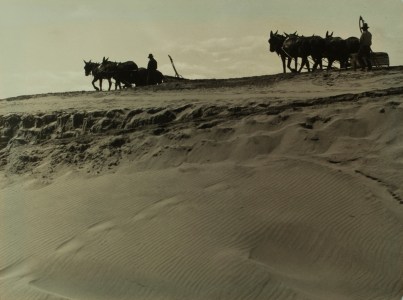
silver print. Partial and promised gift of Frank and Marian Sata and Family. Collection of the Japanese American National Museum.
This Saturday, May 7, at 2 p.m., JANM will present a dramatic reading of Moss on the Mirror, a fictional play inspired by the life and work of renowned photographer Toyo Miyatake. Taking place in Los Angeles’ Little Tokyo district in the late 1920s and early 1930s, where Miyatake’s practice flourished before World War II, the play examines the creativity, hope, and optimism, as well as the struggles and challenges, of the Japanese immigrant photographers community.
Although not a literal retelling of actual events, the piece seeks to transport audiences to the feelings and circumstances of those times. Moss on the Mirror was written by Warren Sata, whose paternal grandfather was J.T. Sata (1896–1975), a featured photographer (along with Miyatake) in the current exhibition Making Waves: Japanese American Photography, 1920–1940. To learn more about the play, we conducted a brief interview with Sata via email.
JANM: What does the title Moss on the Mirror refer to?
Warren Sata: The title refers to the notion that we understand ourselves and our communities through reflection, or looking in the mirror. The moss evokes a clouded mirror, alluding to the influence of outside circumstances like poverty and racism.
JANM: What inspired you to write this play?
WS: The story of Los Angeles’ Issei photographers has fascinated me and inspired my imagination since I learned about them from my father some years ago. A conversation with actor/director Chris Tashima, who serves as the play’s director, helped me to recognize the importance of Toyo Miyatake’s journey toward becoming a pillar of the community. I began to understand the value of artistry and responsibility in a different way, which led me to take an interest in sketching the story of Japanese Americans photographers and their interests and practices prior to the WWII incarceration.

Partial and promised gift of Frank and Marian Sata and Family.
Collection of the Japanese American National Museum.
JANM: What is your favorite image by a Japanese American photographer, and why?
WS: I am drawn to an abstract self-portrait created by my grandfather, J.T. Sata, which is currently on display in Making Waves. It utilizes triangles and a photographic image of his face. The interplay between a realistic portrait and an abstract prepared background fascinates me; it seems to suggest a doorway between the real world and subjective experience. This allows for a dialogue between these worlds and gives value to the notion of participating in both. I enjoy this because it pushes me to understand the Issei experience and what that might have felt like.
JANM: What do you hope audiences will get out of the dramatic reading?
WS: I hope that audience members will be motivated to honor the contributions of the Issei photographic pioneers, but also to consider what their experiences were like in the 1920s and ’30s—their creativity, their principles, their aesthetics, and the culture and context of the times.
Moss on the Mirror is free with museum admission, but RSVPs are recommended.



![Anna May Wong. Photo: Carl Van Vechten [Public domain], via Wikimedia Commons.](https://i0.wp.com/blog.janm.org/wp-content/uploads/2016/03/Anna_May_Wong_1.jpg?resize=235%2C300&ssl=1)






















